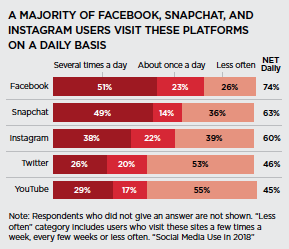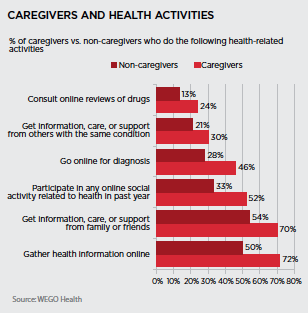Data from the second quarter of 2018 show that Facebook had 2.23 billion monthly active users, while Twitter had 326 million active users in the third quarter of 2018. Consumers use social media for many reasons today, including to learn about a medicine or illness.
The use of social media forums is maturing and many companies are starting to work out how and when to make use of these social forums.
How well these forays into social media are resonating with patients and consumers, however, varies.
According to analysis of social media activity, around half of 20 companies tracked were experiencing declines in engagement, sometimes with large falls. Some companies, however, bucked the trend and experienced increased engagement, which media organizations believe can be attributed to the type of content posted and the decision to use paid promotion of their content at an appropriate time for the right audience.
A separate social media ranking of pharma companies looked at the performance of companies on Twitter to determine how well they balance community engagement with leveraging social media for promotional purposes. Enjoying success on social media requires a strategic approach, experts have found, in which companies work to become part of the community they are reaching out to, connect with relevant stakeholders, and understand the strengths or weaknesses of the various forums they are using.
Know Your Objectives
Throwing ideas about a social media campaign against the wall and hoping they will stick won’t work. Instead, pharmaceutical companies need to have a targeted, well-thought out approach.
One pharma company that has been highlighted for its effective approach to social media is GlaxoSmithKline, which makes use of forums including Facebook, LinkedIn, Twitter, YouTube, and Flickr. The company adjusts its content and approach for each forum, engaging people with what GSK is doing through LinkedIn posts, posting more feel-good stories on Facebook, and having multiple profiles on Twitter used for various reasons, such as a dedicated handle to enable engagement during conferences.
While the strategies are well-considered, the company’s social media experts do believe in experimenting with different ideas and forums and learning from those experiences. Such experiments, however, should be undertaken with advice from legal and compliance experts.
By some reports, Novo Nordisk is leading the way in terms of social media engagement. For example, in Canada Novo Nordisk launched a social media advertising campaign for its Type 2 diabetes product Ozempic on LinkedIn that aims to build awareness, name recognition, and interest in the product among healthcare professionals. Company officials say they are continuing to monitor the success of the initiative, and so far indications show that the program is helping to engage physicians, who are following up to get more information. The company also has a wide range of social media pages dedicated to disease awareness, such as Facebook pages on hemophilia and diabetes, as well as Twitter and YouTube pages focused on diabetes awareness.
Realizing Outcomes with Social Media
Experts in social media programs advise pharmaceutical companies to step back and ask some key questions about their objectives. These include which stakeholders they hope to engage with their social media presence, what outcomes they are looking for, and how they will measure the results.
Experts say another area where social media has huge potential is with patient recruitment. Yet, often recruitment sites use antiquated methods to get patients into clinical trials, such as going through binders of patient profiles.
But social media, if used judiciously, can be a powerful tool for patient recruitment, especially in some areas such as rare diseases. For example, a social media approach could be developed to allow sponsors to reach patients of a particular age or gender who are interested in information about a particular health condition, and then further narrow the outreach to people within a certain radius of the clinical trials.
Additionally, caregivers of patients with rare disease are extremely active on social media platforms. They are also highly educated about the disease, so it’s important that any communications are genuine, transparent, and address the specific area of research.
The approach will need to be carefully thought through, with attention to the creative leveraged. In addition, any recruitment drive must make it easy for patients to engage, such as click-to-call features.
And any patient recruitment initiative on social media must also reach out to healthcare practitioners so that if a patient discusses a trial with his or her doctor, that provider is aware of the clinical trial being discussed.
Care must be taken with how social media is used, taking into account data collection and demographic challenges when recruiting patients. In a study published in JMIR, researchers used a private Facebook community to recruit patients on autoimmune hepatitis. While recruitment was high for the type of study – 29 subjects from 20 states – researchers found inconsistencies between patient-reported data and medical records. However, traditional recruitment methods have been found to have similar issues, so social media itself isn’t necessarily the issue.
In their study conclusion, the researchers noted that careful use of social media can overcome limitations in rare disease research and reach important and engaged research communities.
As life-sciences companies consider the different ways to leverage social media — patient engagement, promotional purposes, patient recruitment — they must ensure any strategy meets regulatory guidelines, that it reaches patients or consumers where and when they want to be reached, and that the objectives of any social media campaign are clear.(PV)
~~~~~~~~~~~~~~~~~~~~~~~~~
Executive viewpoints
 Brandie Linfante
Brandie Linfante
Senior VP, Digital Engagement Strategy,
Ogilvy Health
Create Genuine Connections
The top must-do in social marketing is be authentic. Make sure your brand is represented appropriately and genuinely. Additional must-dos include: understand your audience, create goals and the roadmap to achieve them; choose the appropriate social channels; and monitor, analyze, and tweak your campaigns as needed. Never let your social media channels go stagnant, causing a poor representation of your brand. Be prepared to put the required thought and muscle behind everything you do.
 Martha Maranzani
Martha Maranzani
Senior VP, Digital Engagement Strategy,
Ogilvy Health
Audience-Centricity Is Key to Success
User-centricity is the key to success for pharmaceutical companies in social media. Brand managers must fully understand each audience segment and their specific needs, and then create relevant content for each audience that speaks directly to those needs. This is the only way that pharmaceutical brands can ensure they are being authentic and are well-received in social media. The key is to lead with the end user, not with the brand.
~~~~~~~~~~~~~~~~~~~~~~~~~
A Social Media Snapshot
Twitter estimates an average of 330 million monthly active users across the globe in Q4 of 2017, a 4% increase from 2016.
There are more than 450 million LinkedIn user accounts.
Worldwide, there are more than 2 billion monthly active Facebook users.
Instagram boasts 800 million monthly active users.

While most people are using social media at least occasionally, it’s even more eye-opening to note that a huge number of people are visiting social media platforms daily or even several times a day. Pew Research shows that a majority of Facebook, Snapchat, and Instagram users are engaging with the platforms on at least a daily basis.
More than half of Facebook users say they visit Facebook several times a day — nearly half say the same about Snapchat. About 38% of Instagram users are opening the app several times a day, and just more than a quarter of Twitter and YouTube users are using the platforms several times a day.
Across all platforms, social media is visited with great frequency
When it comes to healthcare specifically, a WEGO Health behavioral intent study found that Facebook was the most popular platform:
87% of study participants say they share health information via Facebook posts
81% of study participants say they share health information via Facebook message
Of significance is the fact that 91% of participants said online communities play a role in their health decisions.
With social media, the statistics specifically about engagement are even more interesting. According to Sprout, Instagram leads in terms of engagement. People are actively engaging on Instagram by  commenting, liking, and sharing at a rate 84 times more than Twitter, 54 times more than Pinterest, and 10 times more than Facebook.
commenting, liking, and sharing at a rate 84 times more than Twitter, 54 times more than Pinterest, and 10 times more than Facebook.
On Facebook, recent changes to the platform’s news feed feature have led to patient leaders seeing a boost to their overall engagement. In a WEGO Health Case Study of the Alzheimer’s Reading Room, it was found that while only 3% of posts had an engagement rate of more than 10% before the news feed changes, 79% of posts had an engagement rate of more than 10% after the changes. Caregivers are especially active in using the Web and social media as a resource for gathering health information and support. Research from Pew found that 52% of caregivers had participated in an online social activity related to health in the past year, and 70% were seeking out information and to support online for their loved one.

















